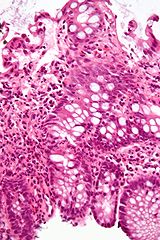Nieswoiste zapalenia jelit
| ||
 | ||
| ICD-10 | K50 Choroba Crohna (choroba Leśniowskiego-Crohna) | |
| ICD-10 | K51 Wrzodziejące zapalenie jelit | |
| ICD-10 | K52.8 Kolagenowe zapalenie jelit Eozynofilowe zapalenie żołądka i jelit Limfocytowe zapalenie jelita grubego Mikroskopowe zapalenie jelita grubego | |
| ICD-10 | K55.1 Niedokrwienne zapalenie jelita grubego (przewlekłe) | |
| ICD-10 | K55.9 Niedokrwienne zapalenie jelita grubego (nieokreślone) | |
| ICD-10 | M35.2 Choroba Behçeta | |
Nieswoiste zapalenie jelit (ang. inflammatory bowel disease, IBD) – grupa przewlekłych chorób zapalnych przewodu pokarmowego, głównie jelita grubego lub cienkiego.
Najczęstszymi chorobami z tej grupy są choroba Leśniowskiego-Crohna i wrzodziejące zapalenie jelita grubego[1][2][3].
Należą do nich również:
- kolagenowe zapalenie jelit
- eozynofilowe zapalenie żołądka i jelit
- choroba Behçeta
- niedokrwienne zapalenie jelita grubego
Przypisy
- ↑ Baumgart DC., Sandborn WJ. Inflammatory bowel disease: clinical aspects and established and evolving therapies.. „Lancet”. 9573 (369), s. 1641–57, maj 2007. DOI: 10.1016/S0140-6736(07)60751-X. PMID: 17499606.
- ↑ Xavier RJ., Podolsky DK. Unravelling the pathogenesis of inflammatory bowel disease.. „Nature”. 7152 (448), s. 427–34, lipiec 2007. DOI: 10.1038/nature06005. PMID: 17653185.
- ↑ Baumgart DC., Carding SR. Inflammatory bowel disease: cause and immunobiology.. „Lancet”. 9573 (369), s. 1627–40, maj 2007. DOI: 10.1016/S0140-6736(07)60750-8. PMID: 17499605.
Bibliografia
| Ta sekcja od 2021-06 zawiera treści, przy których brakuje odnośników do źródeł. |
- M J Carter, A J Lobo, S P L Travis. Guidelines for the Management of Inflammatory Bowel Disease in Adults. „GUT. An International Journal of Gastroenterology and Hepatology”. 53(Suppl V), s. v1–v16, 2004. DOI: 10.1136/gut.2004.043372 (ang.).
- Gary R. Lichtenstein, Maria T. Abreu, Russell Cohen, William Tremaine. American Gastroenterological Association Institute Medical Position Statement on Corticosteroids, Immunomodulators, and Infliximab in Inflammatory Bowel Disease. „GUT. An International Journal of Gastroenterology and Hepatology”. 130 (3), s. 935-939, 2006. DOI: 10.1053/j.gastro.2006.01.047 (ang.).
- Anna Mokrowiecka, Ewa Małecka-Panas. Różnicowanie i leczenie nieswoistych chorób zapalnych jelit. „Przewodnik lekarza”. 10 (1), s. 56-65, 2007 (pol.).
![]() Przeczytaj ostrzeżenie dotyczące informacji medycznych i pokrewnych zamieszczonych w Wikipedii.
Przeczytaj ostrzeżenie dotyczące informacji medycznych i pokrewnych zamieszczonych w Wikipedii.
Media użyte na tej stronie
The Star of Life, medical symbol used on some ambulances.
Star of Life was designed/created by a National Highway Traffic Safety Administration (US Gov) employee and is thus in the public domain.Autor: Nephron, Licencja: CC BY-SA 3.0
High magnification micrograph of cryptitis in a case of Crohn's disease. H&E stain. Colonic biopsy of the mucosa.
The micrograph show numerous neutrophils within the crypt and several eosinophils. The findings in this image (alone) are not diagnostic for Crohn's disease.
The deep aspect of the biopsy has larger hyperchromatic, i.e. darker staining, nuclei, as is typical of the crypt base. The nuclei "mature", i.e. get smaller and less hyperchromatic, toward the superficial aspect; this is a normal finding, which is often absent in dysplastic lesions (e.g. tubular adenoma).




